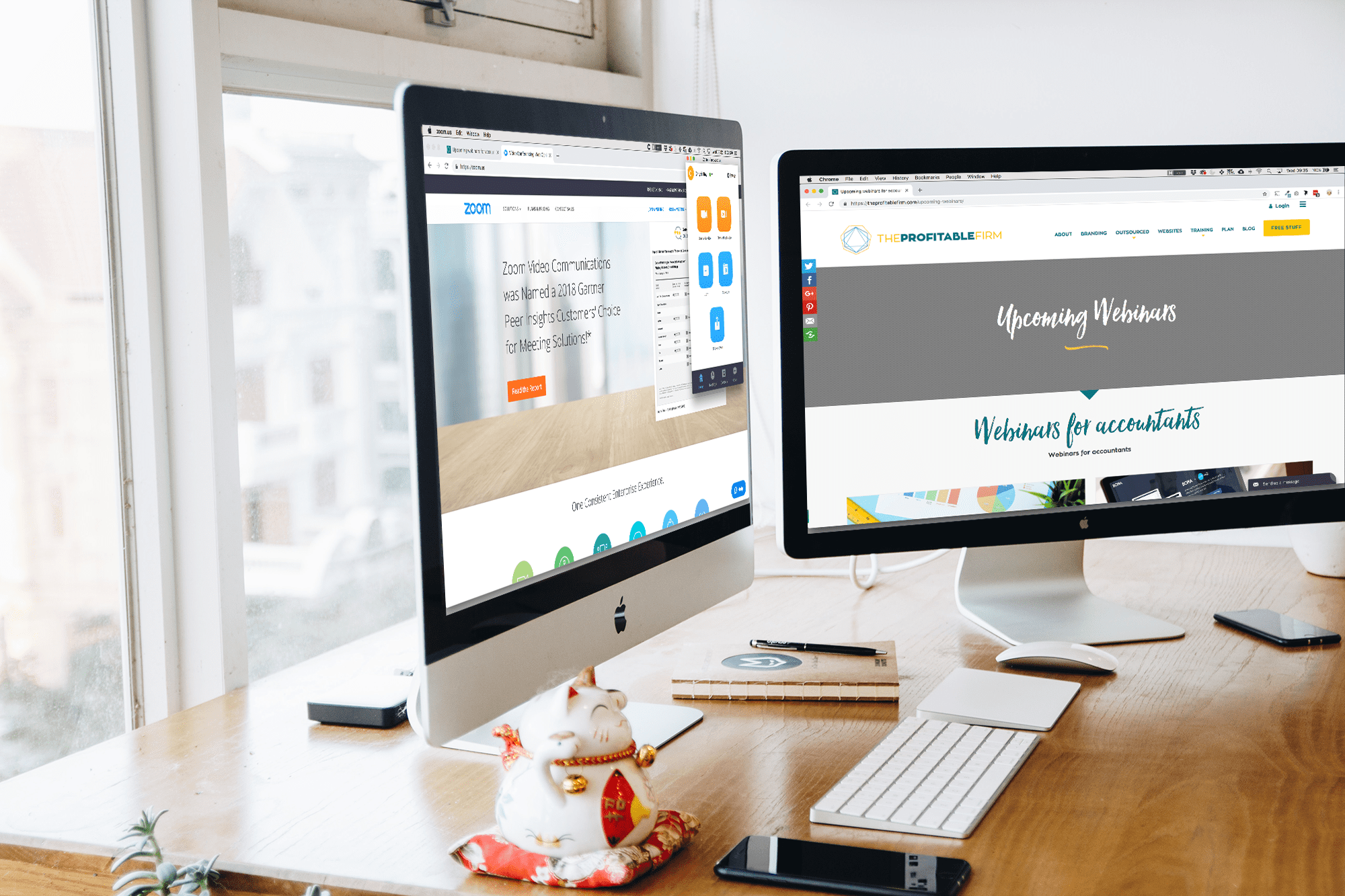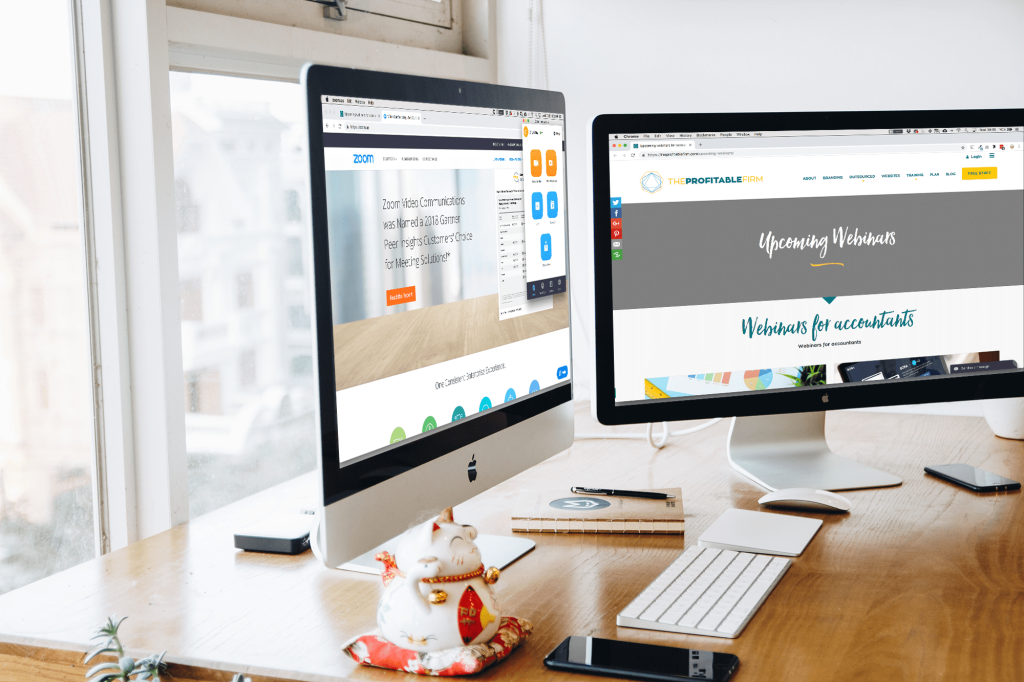 Delivering an online event is significantly different from a live event.
Delivering an online event is significantly different from a live event.
I’ve provided webinars for years – since the inception of PF and before. In the process I’ve learned a few things about the differences between online and offline events, and the primary difference is the buyer’s progression takes longer with online events.
Webinars were one of the first products we sold when I started PF – it was called Business Builder, and the intention was to provide a tool to help accountants deliver recurring webinars to their clients.
It seemed like a great idea. So simple, so repeatable. Create great content, good guest speakers, deliver it online with the ‘evergreen’ style, customise it to each firm with their brand, and see the leads trickle in.
But many accountants weren’t ready to deliver webinars yet. It didn’t work. Accountants were expecting forty, fifty, a hundred attendees at each webinar, and instead were getting one or two, or ten. Why was it taking so long? Why weren’t people signing up? When they attended, why didn’t they buy straight away?
We learned a great deal about delivering online events through that process – and have continued to learn more as the years have gone on.
Webinars can be an extremely powerful way to build relationship with potential clients. They’re also harder, take more effort, and need to be part of an overall plan if they’re going to truly work.
Here’s what we learned about webinars, and what you can consider if you’re thinking of delivering them:
You must have the marketing foundations in place first, before attempting a webinar
One of the reasons webinars didn’t work for some firms was they hadn’t yet addressed the foundational marketing elements. You must have these in place before you even consider delivering webinars:
- Brand: A clear brand, good logo, and visuals to match
- Audience & Buyer Journey: Clarity on who exactly you’re serving, and the needs they have
- Website: A clean, easy-to-navigate website based on the buyer journey, and was a good visual representation of the firm’s brand
- Email: A solid database of people who trust you and want to hear from you
- Social media: Consistent content and conversations on social platforms
Without these in place, delivering webinars simply becomes a process of pushing generic content.
In the case of the ‘Business Builder’ webinars, they had to be broad in scope, because they were being delivered to all sorts of businesses. Small, large, been in business for years, new startups, fast growing, tech, crafts, hobby, corporate.
The spread was too vast, the audience too wide.
Even if you’re delivering a focused, targeted webinar on a useful topic, you still need to have all those other foundational elements in place – so you can prepare and follow up properly. So you can get the most from the delivery.
Your webinar must be part of a greater marketing campaign
Delivering one webinar on its own (rather like delivering any marketing elements on its own) gives false results. Marketing is about building relationships with your prospective clients, so this webinar is only a tiny part of what they see from your firm. Some questions to ask are:
- How does your webinar fit into the bigger picture?
- Who’s your target audience?
- What else are you providing to them before and after the webinar?
- Why would they come?
- What will they do after they come?
- What if they don’t want to do anything yet?
Having answers to all these questions will ensure a more accurate picture of whether it’s successful or not.
Remember, looking to one marketing action to deliver results all by itself is a false picture. If you say, “we ran one webinar and only got three people, so that was a fail”, you may not have all the information. What was the webinar title? How many people did you invite? How long did you prepare? Were you clear? Were they clear about why they were coming and what they got?
Tracking your numbers will be a critical part of this. It’s not solely the numbers of the webinar itself – it’s the numbers before and after, and paying attention to comments made months or years later. We still get people coming to PF who have been watching our recorded webinars for years first. It’s a long term game.
Your presentation must be clear, with one call to action
Running a webinar is not a way to avoid public speaking. It’s one of the most challenging versions of public speaking, because unless it’s a small group with video, you can’t see your audience.
It’s got all the challenges of public speaking – keeping their attention, getting feedback, getting to the point, encouraging action – with the extra challenges of not always having eye contact, body language, or the ability for a response.
Before delivering a webinar, make sure you’ve done these things. (These actions presume you are offering the webinar free, which I would recommend in the first instance.)
Your webinar topic is clear: It gets the point across, and it’s obvious what the purpose is. It’s easy for someone to decide if it’s relevant.
You’re focusing on a unique audience: You’re not reaching everybody – you are specific to one audience with one particular need
You’ve taken presentation training: This is a presentation, and requires as much (if not more) effort than a presentation in front of a live audience. Prepare, plan, and practice.
You’ve identified the ONE thing you want them to do after: This is your call to action. If you have fourteen different options that you sprinkle throughout the webinar, one or two people may take some action. Have one option, and present it over and over throughout the webinar. That way more people will at least be aware of it, much less take action on it. Ideally this ONE thing is a paid option, since your webinar is (presumably) free.
You have a second option for those who aren’t ready to buy: Not everyone is ready to invest money after attending one webinar, so have a backup call to action for those who need more time. This is part of your progression model: helpful free stuff that builds buyer trust.
How many registrations and leads can I expect from my webinar?
Now we get to the good stuff. Even once you’ve done all the preparation work, you’re still wondering how many registrations you’ll get, and how many leads to expect for all the work you’re putting in.
You’ll probably get fewer than you think at first – but if you’re consistent, it can be really beneficial in the long run.
The lead cycle for a webinar can be a bit longer than other events, because:
- There are so many webinars available. Free information is everywhere.
- People tend to sign up for webinars, and then not show up. It’s an easy thing to cancel, when something comes up or they simply can’t be bothered.
- It can miss out on the personal connection (eye contact, body language, physical presence). Some webinars feel really formal, or the attendee is aware they’re only one of many people.
- Webinars encourage multi-tasking. People are not giving you their full attention, and it’s not obvious if they are distracted.
- Expectations are high of audio and video content online. Your audience is used to an amazing delivery, and webinars can give a bad impression. If it’s not done brilliantly well, people get bored or leave or don’t pay attention.
- Depending on your topic, there might be a lot more they need to learn before they’re ready to buy. One hour is not enough.
- Many people sign up for a webinar with the intention of catching the recording later. Not only do they have no intention of showing up live, they may not even take the time later to listen to the recording, so you need to keep going until they are ready.
The key is, how many people are in a trusted relationship with you? The more people who trust you and like you, the more registrants you get.
In terms of actual leads, it depends on your business model, your buying cycle, how good your webinar was, and how ready your buyers are.
In order to determine the success of your webinar and your marketing campaigns, know your lead-to-sale cycle. How long does it take, on average, for your buyer to actually buy? From the first moment they’re vaguely aware of you to the day they sign the proposal, are you looking at 2 months? 12 months? 36 months?
Our buyer cycle at PF averages around 12 months. It can take a lot of time to build trust with accountants who have had bad experiences with marketing, or who need to get ready to invest £1k – £3k/month and understand how that can work. But that’s us. Yours will be different – everyone has a slightly different buyer cycle.
The more you know about your buyer cycle, the better decisions you can make about how to move people along it. Where do they get stuck? What can you learn from those who ask for a proposal and take months and months to accept it? How can you move them along without adding pressure or being salesy, but reminding them of your presence?
If you only get a few people, but the response is good, don’t despair. Do your webinars really well, and keep going. Record it. Share the recording later. Use elements of it in all your marketing, and be persistent.
When done well, webinars are helpful and build trust with your potential buyer. That means your buyer takes action when they’re ready: and that’s what you want.

